Save Lake Toya from Signal Crayfish
January 15, 2008
Signal Crayfish and Its Discovery in Lake Toya
In an underwater shooting by some news medium in September, 2005, the inhabitation of the signal crayfish was confirmed in Lake Toya in Shikotu-Toya National Park.
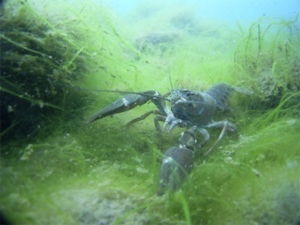
Signal Crayfish in Lake Toya
The signal crayfish, originally from North America, is said to have been introduced to Lake Mashu for food around 1930 and 1940 and spread to other parts of Hokkaido. It is now observed in various areas of Hokkaido, including Lake Shikotsu in Shikotu-Toya National Park.
The signal crayfish, which poses many serious threats to the ecosystem in Japan, has been added to the controlled species list of Invasive Alien Species Act in February, 2006. The feared impacts on the environments are;
- Competition with the native Japanese crayfish
- Wider spread of crayfish pest*
- Predation of native shellfish, aquatic insects, water plants
*Crayfish pest:Crayfish pest is a kind of water mold. Japanese crayfish dose not have immunity to the mold, and it is cinsidered as a fatal disease to them.
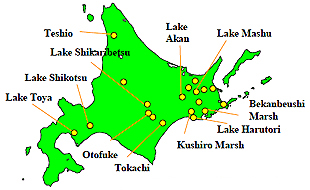
Inhabitation Map of Signal Crayfish
Invasive Alien Species Act prohibits bringing live individuals of the controlled species to outdoor or releasing in rivers or lakes in Japan. However, the signal crayfish already living in the nature is still threatening the environment across the nation by its reproductive activities and invasion to wider areas.
Preventive Measures Against Signal Crayfish
In order to establish an effective capturing system and method in the area, the Ministry of the Environment has been conducting various surveys of the signal crayfish since 2006. In addition to capturing signal crayfish in the lake, the captured location and season are recorded along with the size of individuals, and the collected data is used to plan future capturing projects. The inhabitation areas are also monitored by the traps placed all over the lake as well as through underwater investigation. For further understanding in necessity of the signal crayfish extermination, educational programs for residents and underwater capture program by volunteer divers are conducted.
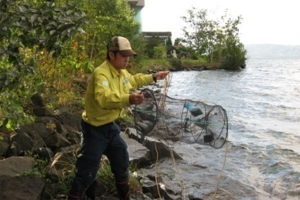
Setting Traps
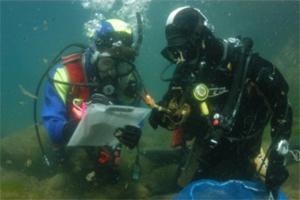
Divers Capturing Signal Crayfish
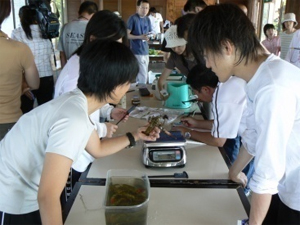
Junior High School Students Observing Signal Crayfish
Your Action Wanted to Save the Environment
Alien species imbalance ecosystems and bring unpredictable problems that otherwise would not occur. In order to protect the natural environment in Japan, please follow the principles against alien species.- Do NOT Introduce
Do not bring in alien species to Japan. - Do NOT Release
Do not release live alien species to outdoors. - Do NOT Spread
Do not transport live alien species to other areas.
For more information, please visit the links below.
- Invasive Alien Species Act (Ministry of the Environment, in Japanese):
http://www.env.go.jp/nature/intro/index.html - What are Alien Species(for Children, in Japanese):
http://www.env.go.jp/nature/intro/kids/index.html

